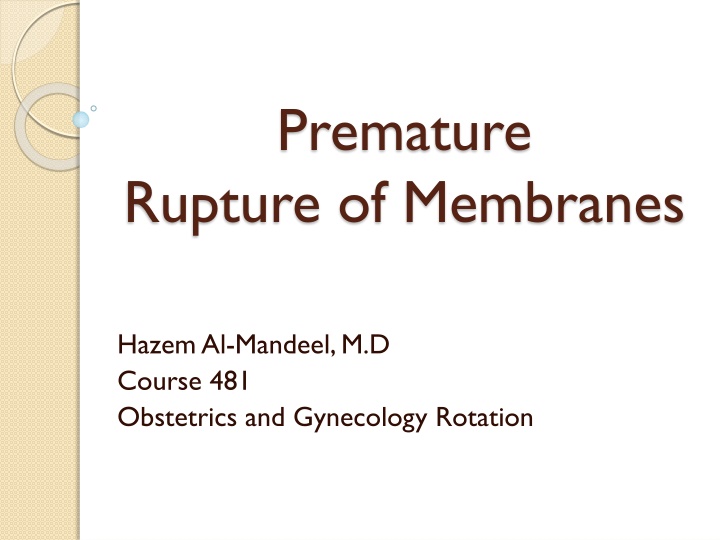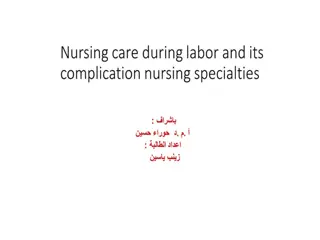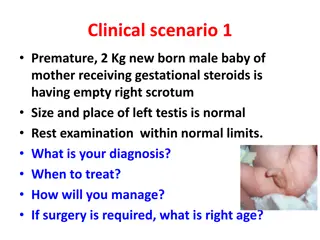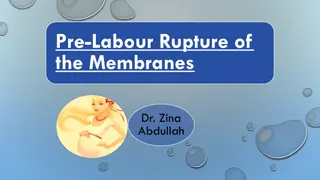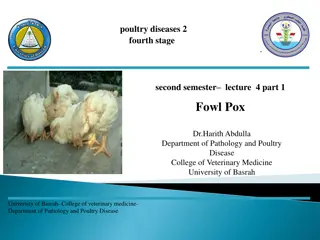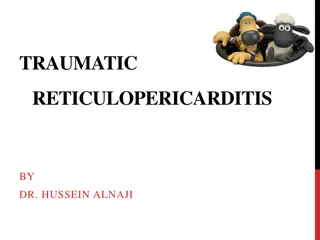Premature Rupture of Membranes: Diagnosis and Management Overview
Premature rupture of membranes (PROM) is a complication in pregnancy where the amniotic sac breaks before labor begins. Risk factors include infections and multiple gestations. Diagnosis involves history, physical examinations, and tests like nitrazine and ferning tests. Management depends on gestational age, with considerations for risks of preterm delivery and infections. Options range from conservative monitoring to early delivery, with emphasis on minimizing maternal and fetal risks. Your go-to guide for understanding and addressing PROM in obstetrics and gynecology.
Download Presentation

Please find below an Image/Link to download the presentation.
The content on the website is provided AS IS for your information and personal use only. It may not be sold, licensed, or shared on other websites without obtaining consent from the author.If you encounter any issues during the download, it is possible that the publisher has removed the file from their server.
You are allowed to download the files provided on this website for personal or commercial use, subject to the condition that they are used lawfully. All files are the property of their respective owners.
The content on the website is provided AS IS for your information and personal use only. It may not be sold, licensed, or shared on other websites without obtaining consent from the author.
E N D
Presentation Transcript
Premature Rupture of Membranes Hazem Al-Mandeel, M.D Course 481 Obstetrics and Gynecology Rotation
Definition Premature rupture of membranes (PROM) is a spontaneous rupture of membranes prior to onset of labor at any gestational age Preterm PROM if it occurs prior to 38 wks of gestation (other names: prelabor preterm ROM) Etiology is unknown (? subclinical infection) Risk Factors include: Vaginal or cervical infection Incompetent cervix Multiple gestation
Diagnosis History of: vaginal loss of fluid Dx is confirmed by vaginal examination (sterile speculum) looking for pooling of fluid in the vagina Fluid coming out from cervical os Nitrazine (pH) test Ferning test Obstetrical ultrasound can help in diagnosis especially if the amniotic fluid volume is low Lab tests doesn t always help in the management
Management of PROM Management of PROM in preterm fetuses depends on the balance between the risks of preterm delivery and risks of mother or fetal infection/sepsis Risks of PPROM include: Preterm delivery and neonatal prematurity syndrome Maternal/fetal infection (chorioamnionitis) Abruptio placenta Cord prolapse If early PROM (<24wks) and limb contractures pulmonary hypoplasia
Management of PROM If PROM occurs at 36 wks or more consider delivery because risks outweigh benefits If PROM occurs before 36 wks, consider two options: 1. Conservative/Expectant management If benefits outweigh any potential risks 2. Interventional treatment/Delivery In cases of confirmed chorioamnionitis In cases of fetal compromise
Management of PPROM Conservative management can be continued until the fetus becomes mature (confirmed lung maturity or 36 weeks) or the risks become higher Admit patient to hospital till delivery Give antenatal corticosteroids Start antibiotics Serial obstetrical ultrasound and non-stress test Use tocolytic (to have time for corticosteroids admin) Consider outpatient management only if reliable patient, no risks, close home, & no
Management of Chorioamnionitis Start I.V broad-spectrum antibiotics Prepare for delivery by induction of labor if no fetal compromise is diagnosed Consider cesarean section if fetus not tolerating labor Inform NICU for neonatal admission and management Continue antibiotics for a minimum of 7 days
